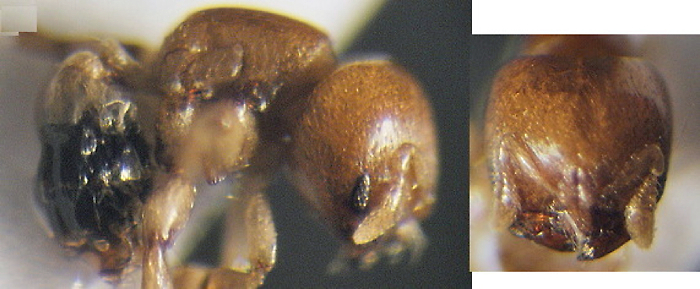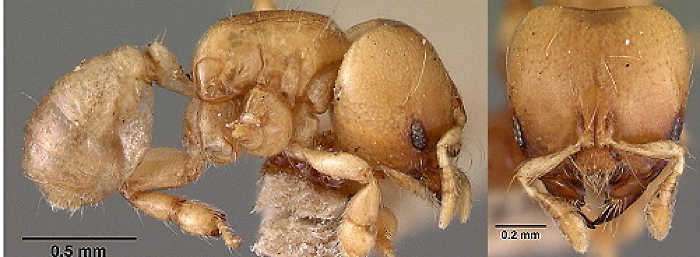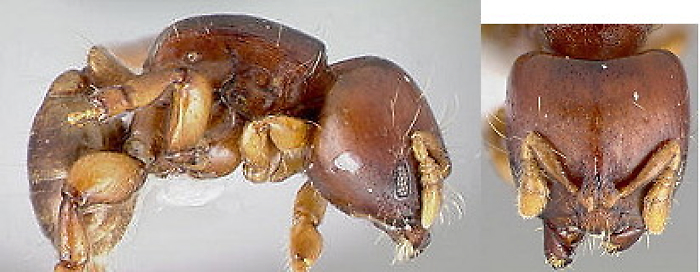SUBFAMILY MYRMICINAE - Genus Melissotarsus
| The Ants of
Africa SUBFAMILY MYRMICINAE - Genus Melissotarsus |
|
| Contents - Myrmicinae - MYRMICINAE Introduction |
In Tribe MELISSOTARSINI.
Diagnostic Features - Antennae 6-segmented with a 2-segmented club, scapes very short. Eyes well developed, noticeably longer than broad. Dorsum of alitrunk smoothly convex in profile, propodeum unarmed. Postpetiole very broadly attached to the gaster. Coxa of middle and hind legs very large. Basal segment of tarsi enlarged, remaining segments small.
Emery's (1877b) genus definition is at ![]() . Arnold (1916: 188) gave an annotated
translation of the genus description; this is at
. Arnold (1916: 188) gave an annotated
translation of the genus description; this is at ![]() .
.
Described by Bolton (1973a) as being uncommon, nesting under the
bark of trees, usually some distance above ground, and rarely found
outside the nest during the day. The extreme case of restricted nesting
was reported by Delage-Darchen (1972) for Melissotarsus weissi
which she studied (as titubans) in the Ivory Coast. Bolton
(1982) synonymised Delage-Darchen's material with beccarii but
in Bolton (1995) the synonymy was changed to being with weissi,
see below. From examination of the written descriptions and
illustrations the matter seems far from clearly resolved to me. The
full text of Bolton's revision can be seen at ![]() .
.
Belshaw & Bolton (1994) noted that two species were known from Ghana, both of which tunnel in living wood.
Key to Afrotropical species (from Bolton, 1982):
| 1 |  Almost totally lacking erect hairs; head and alitrunk
shiny reddish-brown, postpetiole yellow, gaster shiny black;TL 2.0 mm Almost totally lacking erect hairs; head and alitrunk
shiny reddish-brown, postpetiole yellow, gaster shiny black;TL 2.0 mm |
Benin - new species - tchibozoi |
| -- | With quite abundant, fine erect hairs; essentially unicolourous | 2 |
| 2 |  In dorsal view, anterior margin of pronotum rounding
evenly into the anterior declivity; scapes strongly expanded apically;
TL 2.3-3.3 mm; dull yellowish brown to dark yellow In dorsal view, anterior margin of pronotum rounding
evenly into the anterior declivity; scapes strongly expanded apically;
TL 2.3-3.3 mm; dull yellowish brown to dark yellow |
pan-African - beccarii |
| -- | In dorsal view, anterior margin of pronotum with a sharp angle at transition to anterior declivity | 3 |
| 3 |  Sides of alitrunk meeting dorsum in a fairly well defined
angle, alitrunk colour reddish brown; head much narrower anteriorly;
scapes widening progressively from about first quarter; TL 2.3-3.0 mm Sides of alitrunk meeting dorsum in a fairly well defined
angle, alitrunk colour reddish brown; head much narrower anteriorly;
scapes widening progressively from about first quarter; TL 2.3-3.0 mm |
West Africa & Congo Basin - weissi |
| -- |  Sides of alitrunk rounding bluntly into the dorsum,
alitrunk colour yellow to yellowish-brown; anterior margin of clypeus
with a quite dense even row of fairly long fine hairs; TL 2.5-3.4 mm Sides of alitrunk rounding bluntly into the dorsum,
alitrunk colour yellow to yellowish-brown; anterior margin of clypeus
with a quite dense even row of fairly long fine hairs; TL 2.5-3.4 mm |
pan-African - emeryi |
| MYRMICINAE Introduction |
© 2007, 2009, 2010, 2012, 2019 - Brian Taylor CBiol FRSB FRES 11, Grazingfield, Wilford, Nottingham, NG11 7FN, U.K. |
href="melissotarsus.htm"